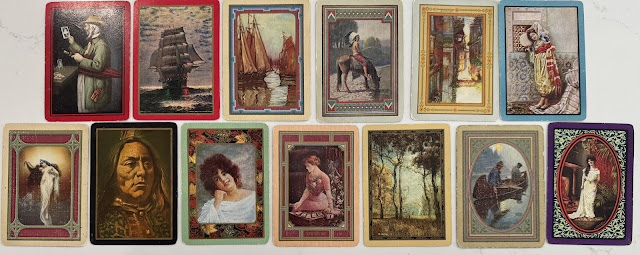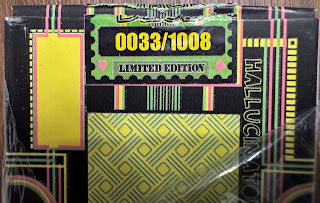Today I'm thinking about my numbered limited edition decks of cards. Here's a handful of limited edition decks from my collection. They number created ranges from 50 (for a hand-painted deck) up to 3200. I just noticed that they mostly have something in common. Try to figure it out and I'll explain it after showing the decks.
My Limited Edition Decks and the Number of Decks Produced
Pim Leefsma/Joop Muller - 250
Bosch by Sunish Chabba - 3200
Peter Wood 2000Pips - 1000
Two Martin Hill Decks - both 53!
E Lewis Aesop's Fables - 50
Graciela Rodo Boulangeris - 9,999 - Does this still count as limited?
Frankendecks by Martin Hill, both #18 out of 53!
The Circus Transformation Deck by F. Robert Schick - 792 out of 1000
I started thinking about them with the passing of Pim Leefsma as written up Joop Muller. Since I know Joop and I have one of the Pim Leefsma's decks (actually three!), I took it out and admired it.
My Pim Leefsma deck is #108 out of 250 (I also have #007 and #076, unopened, available for trade if anyone is interested). The artwork is incredible and I can see why Joop was highly motivated to get a deck created with it. Thanks Joop for creating it and for the write-up on the Pim Leefsma deck and art.
 |
| Pim Leefsma's Artwork on Playing Cards |
My Bosch deck is 0152 of 3200 (and I also have unopened #0243). I discovered Bosch's artwork in a tour of the Prado 2024: amazing! What's astonishing is not just the artwork but while it looks super modern and part of surrealism, the truth is Hieronymus Bosch lived from 1450–1516 so his surrealistic work predates the modern movement by ~500 years. Background note: Surealism is a cultural and artistic movement that began in the 1920s, primarily in Paris, aiming to liberate thought and human experience from the constraints of rationalism by exploring the subconscious, dreams, and the irrational.
The Bosch artwork is presented as diptychs. The artwork is fantastical, religious, deeply symbolic, and it makes me realize how my understanding of this work is relatively superficial.
 |
| Bosch Playing Card Jokers |
My Peter Wood transformation deck is #613 out of one thousand. I bought it (online) from Peter Woods when it first came out. At the time, I was travelling regularly to London on business and tried to arrange a visit with him. It never happened.
 |
Peter Woods Transformation Deck
Note how the nine hearts are integrated in the design |
 |
Let me point them out for you....
|
This Cameo deck is #1356 out of 1500.
I have two Martin Hill Franken decks, both #18 out of 53! The packaging on these two decks is exquisite. They feel like they belong in Diagon Alley (which is part of the Harry Potter world for you illiterate muggles).
 |
| Martin Hill Franken decks, both #18 out of 53 |
You might be wondering what a frankendeck is. For that, you must click through to the Franken Deck Article.
I have #29 out of 50 of these hand-painted transformation decks by Elaine Lewis.
Confession: To be honest, I'm not entirely sure how to interpret "hand-painted". Does this mean, the art is done by hand and then reproduced? Does it mean that the black outlines of the art is done by hand, the deck is then produced, and then each card on each deck is hand-painted. I could go retrieve the deck and hold it up to the light studying the texture to see if there is hand work on each card and if nobody answers the question for me, I might.
UPDATE - I've learned that they each deck is hand-drawn. Elaine Lewis ( per the World Wide Playing Card Museum - WWPCM - website): This artist is making handmade decks with 20-50 copies. "After several months of design work, she draws the cards in outline at 150% size, in designer's pen and black ink, and then has the complete set printed at final size onto sheets of white card. Elaine hand colours each card and cuts out the packs as required."
Click through to understand transformation decks.



Circus Transformation Deck by Schick of 1989 was printed by Cartimundi in 1000 examples. I have #792.
 |
| Robert Schick Circus Deck #792 |
My collecting does not focus on modern limited editions. Yet, I have at least eight of them, why? What do these decks have in common which allowed them to sneak into my collection?
These decks were collected either because of my interest in transformation decks or my interest in fine art. I don't seem to have collected any (or many) outside of the art or transformation arena.
Want to learn more about my collection of playing cards and jokers?
My transformation decks
When and what was the first playing card joker?
Visiting Joop in Zaandijk
I also found one more numbered deck in my collection. Hallucination: It's not so great...Ugly and a weird texture.
My Boulangeris Deck. I also found that I have deck #8505 of an edition of 9,999. The art on the royal cards is by Bolivian artist, Graciela Rodo Boulangeris. The deck is "by" Matthieu Lithographe of France: the publisher is Senans of Switzerland, c.1970. They were published in sets of two, each with three jokers and with a set of poker dice. I only have one of the decks with only one joker and the dice.
 |
| Boulangeris Art deck |
Here's a question: what is the ideal number of decks to print for a limited edition collectable?
Let's assume that the goal is for the deck to be a collectable which is ever-increasingly treasured (and valued).
Print too many and there isn't enough scarcity for them to be highly treasured. But of course, the more you print, the more you can sell and the more you can promote it so people are aware of it. So there's a case for more is better (assuming you can sell them all).
Print too few and the publisher has fewer to sell. But they can tout the limited number as a feature and perhaps get a higher price or sell them faster. But for very small numbers, there's less to sell so less room to spend money trying to establish awareness of the deck. This rule is less true if the artist or publisher has a reputation so marketing is not as necessary.
Does the cost of publishing enter into the decision? Is it four times more expensive to print 1000 than 250 decks?

 🔶
🔶 🔶
🔶 🔶
🔶 🔶
🔶 🔶
🔶 🔶
🔶 🔶 - 1904 - The Shower
🔶 - 1904 - The Shower 🔶 - George Washington on Horseback
🔶 - George Washington on Horseback 🔶 - Jane
🔶 - Jane 🔶 - Viola
🔶 - Viola 🔶 - 1920 - The Ripples
🔶 - 1920 - The Ripples 🔶 - Moorish
🔶 - Moorish  🔶 1908 - Volendam
🔶 1908 - Volendam 🔶 1906 - Moonlight (1906)
🔶 1906 - Moonlight (1906) 🔶1905 - Rose
🔶1905 - Rose 🔶- Sitting Bull
🔶- Sitting Bull 🔶 - Nymph
🔶 - Nymph 🔶 - Poetry
🔶 - Poetry 🔶- Oriental
🔶- Oriental









































